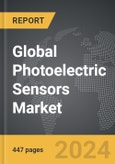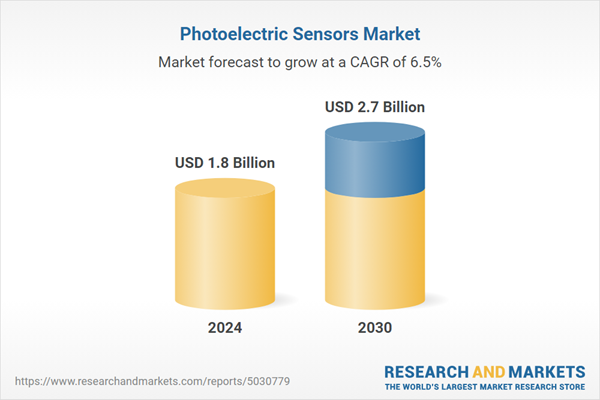The global market for Photoelectric Sensors was valued at US$1.8 Billion in 2024 and is projected to reach US$2.7 Billion by 2030, growing at a CAGR of 6.5% from 2024 to 2030. This comprehensive report provides an in-depth analysis of market trends, drivers, and forecasts, helping you make informed business decisions. The report includes the most recent global tariff developments and how they impact the Photoelectric Sensors market.
Technological advancements have significantly enhanced the performance and application range of photoelectric sensors. Modern sensors are now equipped with advanced signal processing capabilities, enabling them to perform in challenging environments with high accuracy and minimal false detections. Innovations in materials and design have improved their resistance to dust, water, and vibration, extending their usability in harsh industrial conditions. Additionally, the integration of smart technology, such as self-diagnostics and IoT connectivity, allows for real-time monitoring and predictive maintenance, reducing downtime and operational costs. The miniaturization of sensor components has also facilitated their incorporation into smaller and more complex systems, broadening their application scope. Furthermore, advances in light source technology, including the use of lasers, have improved the detection range and precision of photoelectric sensors, making them suitable for applications requiring high sensitivity and long-distance detection.
The growth in the photoelectric sensors market is driven by several factors. The increasing adoption of automation across industries is a primary driver, as these sensors are integral to automated systems for improving efficiency and productivity. The rise of Industry 4.0 and the growing implementation of smart manufacturing solutions are further propelling the demand for advanced photoelectric sensors. Technological advancements, such as the development of more compact, durable, and accurate sensors, are encouraging their adoption in a wider range of applications, including in harsh and challenging environments. The expansion of the e-commerce and logistics sectors, which rely heavily on automated sorting and packaging systems, is also boosting the demand for these sensors. Additionally, the growing focus on safety and security in various sectors, including automotive and consumer electronics, is driving the need for reliable detection and measurement solutions provided by photoelectric sensors. Together, these factors are creating a dynamic and expanding market for photoelectric sensors, presenting significant opportunities for innovation and growth.
Segments: Application (Automotive, Packaging, Electronic & Semiconductor, Military & Aerospace, Other Applications); Technology (Retro-reflective, Diffused, Other Technologies).
Geographic Regions/Countries: World; USA; Canada; Japan; China; Europe; France; Germany; Italy; UK; Spain; Russia; Rest of Europe; Asia-Pacific; Australia; India; South Korea; Rest of Asia-Pacific; Latin America; Argentina; Brazil; Mexico; Rest of Latin America; Middle East; Iran; Israel; Saudi Arabia; UAE; Rest of Middle East; Africa.
The analysts continuously track trade developments worldwide, drawing insights from leading global economists and over 200 industry and policy institutions, including think tanks, trade organizations, and national economic advisory bodies. This intelligence is integrated into forecasting models to provide timely, data-driven analysis of emerging risks and opportunities.
Global Photoelectric Sensors Market - Key Trends & Drivers Summarized
Photoelectric sensors are crucial components in modern automation and control systems, widely used across various industries for detecting the presence, absence, or distance of objects. These sensors operate by emitting a beam of light, typically infrared or visible, and measuring the reflection or interruption of this beam by an object. There are three main types of photoelectric sensors: through-beam, retro-reflective, and diffuse-reflective. Through-beam sensors have separate transmitter and receiver units and detect objects when the beam is interrupted. Retro-reflective sensors combine the transmitter and receiver in one unit and use a reflector to bounce the light beam back; they detect objects when the beam is interrupted before reaching the reflector. Diffuse-reflective sensors also have the transmitter and receiver in one unit but rely on the reflection from the object itself to detect its presence. These sensors are favored for their accuracy, reliability, and versatility in applications ranging from manufacturing and packaging to security systems and robotics.Technological advancements have significantly enhanced the performance and application range of photoelectric sensors. Modern sensors are now equipped with advanced signal processing capabilities, enabling them to perform in challenging environments with high accuracy and minimal false detections. Innovations in materials and design have improved their resistance to dust, water, and vibration, extending their usability in harsh industrial conditions. Additionally, the integration of smart technology, such as self-diagnostics and IoT connectivity, allows for real-time monitoring and predictive maintenance, reducing downtime and operational costs. The miniaturization of sensor components has also facilitated their incorporation into smaller and more complex systems, broadening their application scope. Furthermore, advances in light source technology, including the use of lasers, have improved the detection range and precision of photoelectric sensors, making them suitable for applications requiring high sensitivity and long-distance detection.
The growth in the photoelectric sensors market is driven by several factors. The increasing adoption of automation across industries is a primary driver, as these sensors are integral to automated systems for improving efficiency and productivity. The rise of Industry 4.0 and the growing implementation of smart manufacturing solutions are further propelling the demand for advanced photoelectric sensors. Technological advancements, such as the development of more compact, durable, and accurate sensors, are encouraging their adoption in a wider range of applications, including in harsh and challenging environments. The expansion of the e-commerce and logistics sectors, which rely heavily on automated sorting and packaging systems, is also boosting the demand for these sensors. Additionally, the growing focus on safety and security in various sectors, including automotive and consumer electronics, is driving the need for reliable detection and measurement solutions provided by photoelectric sensors. Together, these factors are creating a dynamic and expanding market for photoelectric sensors, presenting significant opportunities for innovation and growth.
Report Scope
The report analyzes the Photoelectric Sensors market, presented in terms of units. The analysis covers the key segments and geographic regions outlined below.Segments: Application (Automotive, Packaging, Electronic & Semiconductor, Military & Aerospace, Other Applications); Technology (Retro-reflective, Diffused, Other Technologies).
Geographic Regions/Countries: World; USA; Canada; Japan; China; Europe; France; Germany; Italy; UK; Spain; Russia; Rest of Europe; Asia-Pacific; Australia; India; South Korea; Rest of Asia-Pacific; Latin America; Argentina; Brazil; Mexico; Rest of Latin America; Middle East; Iran; Israel; Saudi Arabia; UAE; Rest of Middle East; Africa.
Key Insights:
- Market Growth: Understand the significant growth trajectory of the Retroreflective segment, which is expected to reach US$1.3 Billion by 2030 with a CAGR of a 6.1%. The Through-Beam segment is also set to grow at 6.5% CAGR over the analysis period.
- Regional Analysis: Gain insights into the U.S. market, valued at $390.9 Million in 2024, and China, forecasted to grow at an impressive 7.5% CAGR to reach $551.4 Million by 2030. Discover growth trends in other key regions, including Japan, Canada, Germany, and the Asia-Pacific.
Why You Should Buy This Report:
- Detailed Market Analysis: Access a thorough analysis of the Global Photoelectric Sensors Market, covering all major geographic regions and market segments.
- Competitive Insights: Get an overview of the competitive landscape, including the market presence of major players across different geographies.
- Future Trends and Drivers: Understand the key trends and drivers shaping the future of the Global Photoelectric Sensors Market.
- Actionable Insights: Benefit from actionable insights that can help you identify new revenue opportunities and make strategic business decisions.
Key Questions Answered:
- How is the Global Photoelectric Sensors Market expected to evolve by 2030?
- What are the main drivers and restraints affecting the market?
- Which market segments will grow the most over the forecast period?
- How will market shares for different regions and segments change by 2030?
- Who are the leading players in the market, and what are their prospects?
Report Features:
- Comprehensive Market Data: Independent analysis of annual sales and market forecasts in US$ Million from 2024 to 2030.
- In-Depth Regional Analysis: Detailed insights into key markets, including the U.S., China, Japan, Canada, Europe, Asia-Pacific, Latin America, Middle East, and Africa.
- Company Profiles: Coverage of players such as Hans Turck GmbH & Co. KG, Banner Engineering Corporation, Datalogic SpA, Contrinex AG, Autonics Corporation and more.
- Complimentary Updates: Receive free report updates for one year to keep you informed of the latest market developments.
Some of the 53 companies featured in this Photoelectric Sensors market report include:
- Hans Turck GmbH & Co. KG
- Banner Engineering Corporation
- Datalogic SpA
- Contrinex AG
- Autonics Corporation
- Carlo Gavazzi Holding AG
- Aeco s.r.l.
- HTM Sensors
- Baumer Electric AG
- Di-Soric GmbH & Co. KG
- Fargo Controls, Inc.
- IC-Haus GmbH
- IDEC Corporation
- F&C Sensing Technology (Hunan) Co., Ltd.
- EliteStar International Ltd.
Tariff Impact Analysis: Key Insights for 2025
Global tariff negotiations across 180+ countries are reshaping supply chains, costs, and competitiveness. This report reflects the latest developments as of April 2025 and incorporates forward-looking insights into the market outlook.The analysts continuously track trade developments worldwide, drawing insights from leading global economists and over 200 industry and policy institutions, including think tanks, trade organizations, and national economic advisory bodies. This intelligence is integrated into forecasting models to provide timely, data-driven analysis of emerging risks and opportunities.
What’s Included in This Edition:
- Tariff-adjusted market forecasts by region and segment
- Analysis of cost and supply chain implications by sourcing and trade exposure
- Strategic insights into geographic shifts
Buyers receive a free July 2025 update with:
- Finalized tariff impacts and new trade agreement effects
- Updated projections reflecting global sourcing and cost shifts
- Expanded country-specific coverage across the industry
Table of Contents
I. METHODOLOGYII. EXECUTIVE SUMMARY2. FOCUS ON SELECT PLAYERSIII. MARKET ANALYSISCANADAITALYSPAINRUSSIAREST OF EUROPESOUTH KOREAREST OF ASIA-PACIFICARGENTINABRAZILMEXICOREST OF LATIN AMERICAIV. COMPETITION
1. MARKET OVERVIEW
3. MARKET TRENDS & DRIVERS
4. GLOBAL MARKET PERSPECTIVE
UNITED STATES
JAPAN
CHINA
EUROPE
FRANCE
GERMANY
UNITED KINGDOM
ASIA-PACIFIC
AUSTRALIA
INDIA
LATIN AMERICA
MIDDLE EAST
AFRICA
Companies Mentioned (Partial List)
A selection of companies mentioned in this report includes, but is not limited to:
- Hans Turck GmbH & Co. KG
- Banner Engineering Corporation
- Datalogic SpA
- Contrinex AG
- Autonics Corporation
- Carlo Gavazzi Holding AG
- Aeco s.r.l.
- HTM Sensors
- Baumer Electric AG
- Di-Soric GmbH & Co. KG
- Fargo Controls, Inc.
- IC-Haus GmbH
- IDEC Corporation
- F&C Sensing Technology (Hunan) Co., Ltd.
- EliteStar International Ltd.
Table Information
| Report Attribute | Details |
|---|---|
| No. of Pages | 447 |
| Published | April 2025 |
| Forecast Period | 2024 - 2030 |
| Estimated Market Value ( USD | $ 1.8 Billion |
| Forecasted Market Value ( USD | $ 2.7 Billion |
| Compound Annual Growth Rate | 6.5% |
| Regions Covered | Global |









